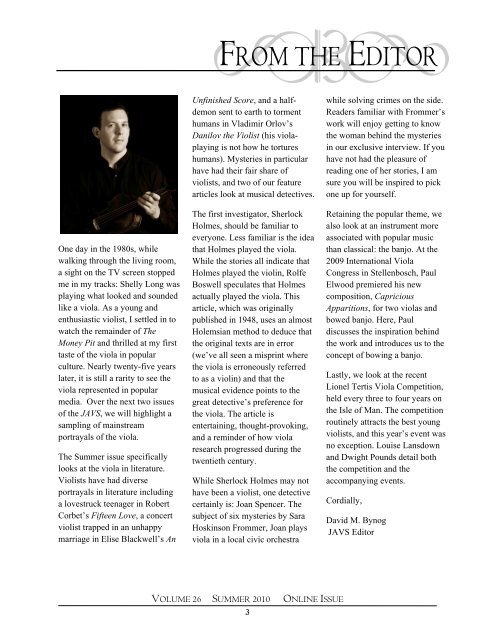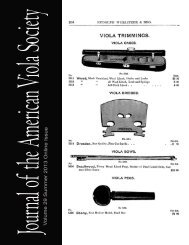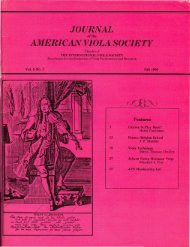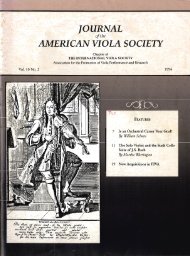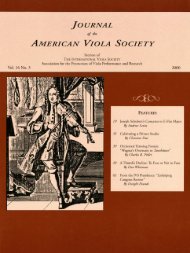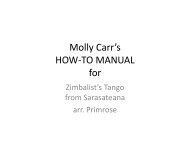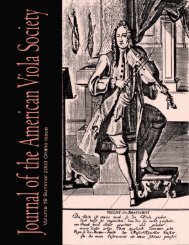Journal of the American Viola Society Volume 26 Online, Summer ...
Journal of the American Viola Society Volume 26 Online, Summer ...
Journal of the American Viola Society Volume 26 Online, Summer ...
Create successful ePaper yourself
Turn your PDF publications into a flip-book with our unique Google optimized e-Paper software.
One day in <strong>the</strong> 1980s, while<br />
walking through <strong>the</strong> living room,<br />
a sight on <strong>the</strong> TV screen stopped<br />
me in my tracks: Shelly Long was<br />
playing what looked and sounded<br />
like a viola. As a young and<br />
enthusiastic violist, I settled in to<br />
watch <strong>the</strong> remainder <strong>of</strong> The<br />
Money Pit and thrilled at my first<br />
taste <strong>of</strong> <strong>the</strong> viola in popular<br />
culture. Nearly twenty-five years<br />
later, it is still a rarity to see <strong>the</strong><br />
viola represented in popular<br />
media. Over <strong>the</strong> next two issues<br />
<strong>of</strong> <strong>the</strong> JAVS, we will highlight a<br />
sampling <strong>of</strong> mainstream<br />
portrayals <strong>of</strong> <strong>the</strong> viola.<br />
The <strong>Summer</strong> issue specifically<br />
looks at <strong>the</strong> viola in literature.<br />
Violists have had diverse<br />
portrayals in literature including<br />
a lovestruck teenager in Robert<br />
Corbet’s Fifteen Love, a concert<br />
violist trapped in an unhappy<br />
marriage in Elise Blackwell’s An<br />
FROM THE EDITOR<br />
Unfinished Score, and a halfdemon<br />
sent to earth to torment<br />
humans in Vladimir Orlov’s<br />
Danilov <strong>the</strong> Violist (his violaplaying<br />
is not how he tortures<br />
humans). Mysteries in particular<br />
have had <strong>the</strong>ir fair share <strong>of</strong><br />
violists, and two <strong>of</strong> our feature<br />
articles look at musical detectives.<br />
The first investigator, Sherlock<br />
Holmes, should be familiar to<br />
everyone. Less familiar is <strong>the</strong> idea<br />
that Holmes played <strong>the</strong> viola.<br />
While <strong>the</strong> stories all indicate that<br />
Holmes played <strong>the</strong> violin, Rolfe<br />
Boswell speculates that Holmes<br />
actually played <strong>the</strong> viola. This<br />
article, which was originally<br />
published in 1948, uses an almost<br />
Holemsian method to deduce that<br />
<strong>the</strong> original texts are in error<br />
(we’ve all seen a misprint where<br />
<strong>the</strong> viola is erroneously referred<br />
to as a violin) and that <strong>the</strong><br />
musical evidence points to <strong>the</strong><br />
great detective’s preference for<br />
<strong>the</strong> viola. The article is<br />
entertaining, thought-provoking,<br />
and a reminder <strong>of</strong> how viola<br />
research progressed during <strong>the</strong><br />
twentieth century.<br />
While Sherlock Holmes may not<br />
have been a violist, one detective<br />
certainly is: Joan Spencer. The<br />
subject <strong>of</strong> six mysteries by Sara<br />
Hoskinson Frommer, Joan plays<br />
viola in a local civic orchestra<br />
VOLUME <strong>26</strong> SUMMER 2010 ONLINE ISSUE<br />
3<br />
while solving crimes on <strong>the</strong> side.<br />
Readers familiar with Frommer’s<br />
work will enjoy getting to know<br />
<strong>the</strong> woman behind <strong>the</strong> mysteries<br />
in our exclusive interview. If you<br />
have not had <strong>the</strong> pleasure <strong>of</strong><br />
reading one <strong>of</strong> her stories, I am<br />
sure you will be inspired to pick<br />
one up for yourself.<br />
Retaining <strong>the</strong> popular <strong>the</strong>me, we<br />
also look at an instrument more<br />
associated with popular music<br />
than classical: <strong>the</strong> banjo. At <strong>the</strong><br />
2009 International <strong>Viola</strong><br />
Congress in Stellenbosch, Paul<br />
Elwood premiered his new<br />
composition, Capricious<br />
Apparitions, for two violas and<br />
bowed banjo. Here, Paul<br />
discusses <strong>the</strong> inspiration behind<br />
<strong>the</strong> work and introduces us to <strong>the</strong><br />
concept <strong>of</strong> bowing a banjo.<br />
Lastly, we look at <strong>the</strong> recent<br />
Lionel Tertis <strong>Viola</strong> Competition,<br />
held every three to four years on<br />
<strong>the</strong> Isle <strong>of</strong> Man. The competition<br />
routinely attracts <strong>the</strong> best young<br />
violists, and this year’s event was<br />
no exception. Louise Lansdown<br />
and Dwight Pounds detail both<br />
<strong>the</strong> competition and <strong>the</strong><br />
accompanying events.<br />
Cordially,<br />
David M. Bynog<br />
JAVS Editor


